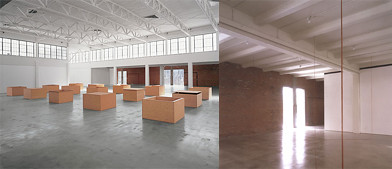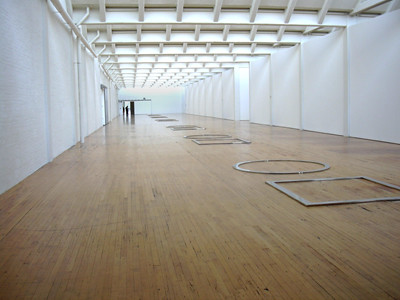
Aerial view, Dia:Beacon, Riggio Galleries, 2002. Photo: Michael Govan. ©Dia Art Foundation.
Why is Charlie Finch complaining about Dia Beacon’s low ceilings when the main space walls range from 16 to 26 feet high? And since when do “long vistas and a wooden floor” interfere with an art viewing experience? I can't pretend to understand what rationale Finch has for the conclusions he draws — it's not like it's included in his write-ups — but I do know this: at least 50% of the opinions published in Artnet's feature on Dia Beacon are wrong, and the rest are superfluous. Here's an example:
“”¦the museum itself, cattycornered to the railroad station, breathes the slightly rarefied, snobbish Zen air that has always been the Dia Trademark. The cafeteria serves an excellent roast beef sandwich.”
Who knows what a roast beef sandwich has to do with art snobbery, but it doesn't appear to matter in this review. As we are raking in the dough here at AFC we brought our own lunch to Dia this week, and ate it on the bench outside. We didn't feel self conscious about it because the grounds seem to be set up specifically for this purpose – though I'm sure we would have if the museum was as snobby Finch suggests. We later joked with an artist who is also a guard at Dia Beacon about our desire to touch the art, which is a rarity in the snooty culture of museums.

Finch doesn't let us dwell on this so called snobbery though, and moves from sandwich review to such critical art discourse as, “”¦Shockingly, an inventory of wooden Donald Judds reeks of Ikea, but Fred Sandback’s string cheese is charming.” Clearly scandalized by the connection between furniture and a Donald Judd, Finch fails to provide any groundwork to back his assertions. The fact of the matter is the Judds aren't very good because they provide no entry point for the viewer; they are banal physically and materially. If the work actually reeked of Ikea, it would probably be better because at least the viewer would have a more interactive relationship with it. As for the Fred Sandbacks, the statement above makes the large assumption that the audience is familiar enough with the artist's work to understand that the piece is not actually made of string cheese. This kind of sloppy writing is only made worse when he goes on to describe minimalist geometric string sculptures as charming. To be clear, a Jeff Koon's Puppy Dog is charming, a strand of taut yarn in the shape of a triangle is not. This doesn't mean the Sandbacks aren't good, but you can't pull blindly from a bag of positive adjectives and hope they work.

The rest of the review is rife with similarly lazy thinking, and glaring omissions such as the fact that majority of the building is lit exclusively by sunlight. This makes the art viewing experience at Dia exquisite, and to leave it out is an indication that the reviewer wasn't paying attention when he visited the museum, or when he wrote the piece. And that's a problem, because as a critic, that’s your job.


Comments on this entry are closed.